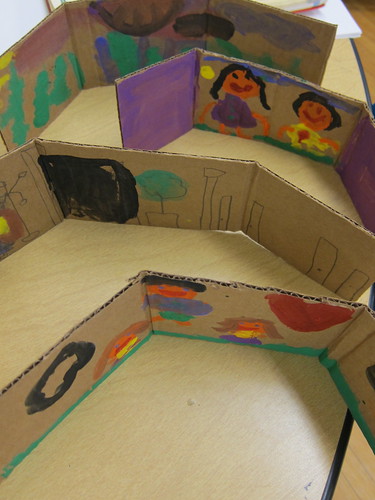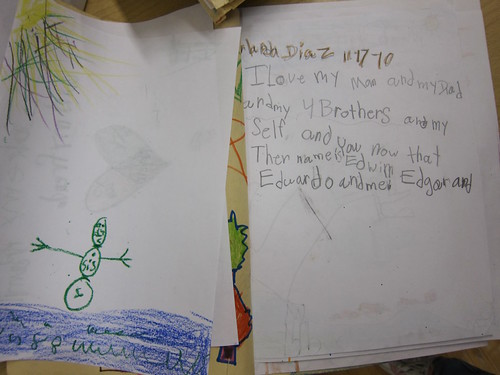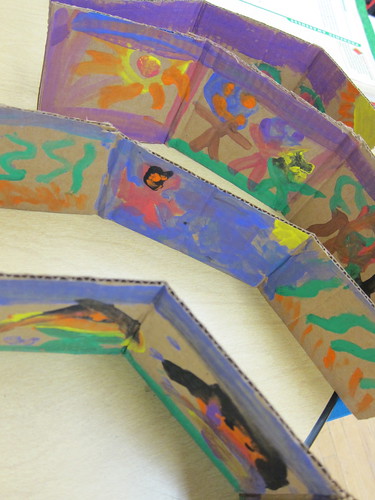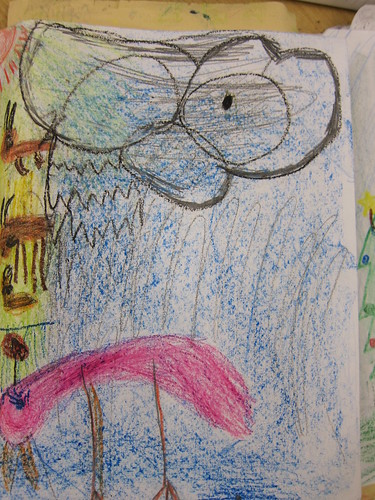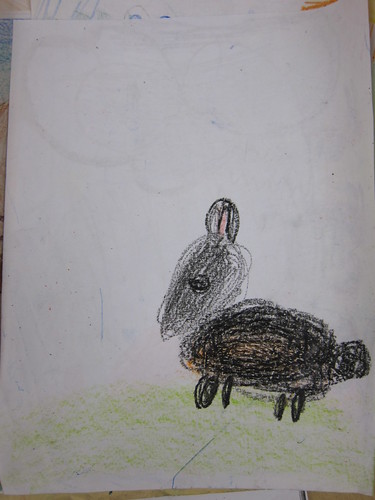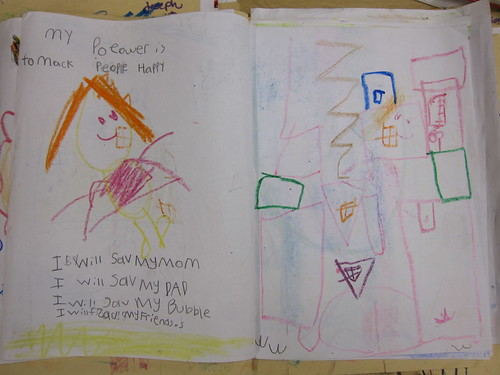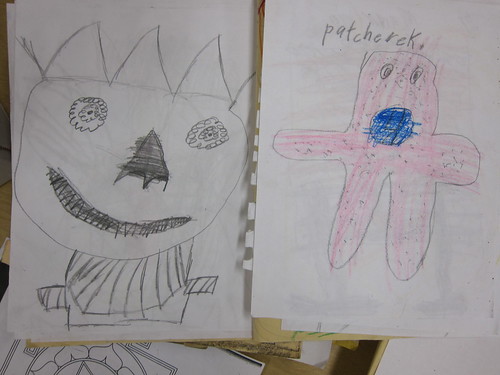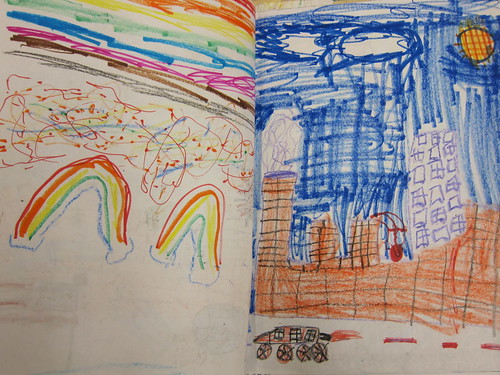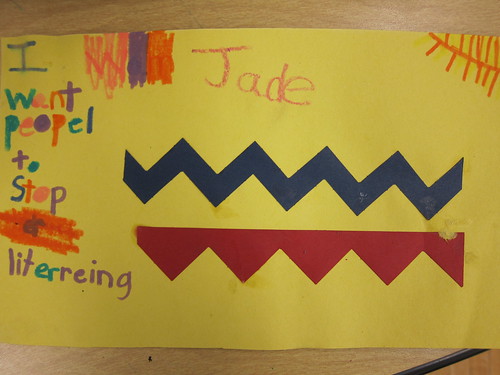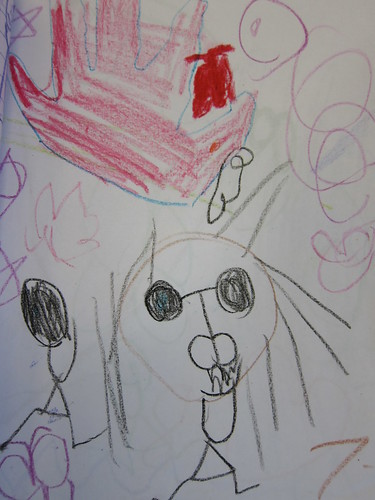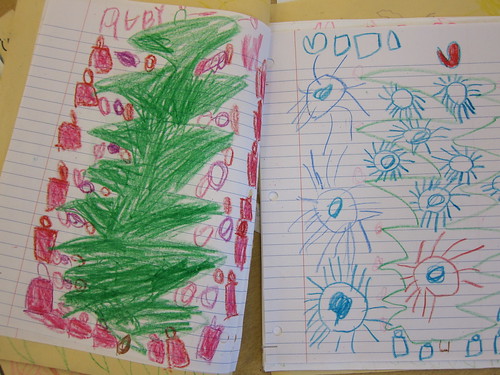Waking up with some Saturday morning reading, we came across this great article on www.good.is, asking if schools can teach entrepreneurship.
Read the article here.
At Living Histories, we of course believe that you can, and it's a big reason we are focusing much of our 12/13 programming on helping students develop the skills that can turn them into the thinkers, planners and doers of tomorrow...young entrepreneurs need to be nurtured and supported!
Saturday, September 01, 2012
Thursday, January 13, 2011
Wednesday, November 24, 2010
Journal Time
Journaling is a big part of the Living History curriculum for all of our student groups, regardless of age. We like to use it as a time to promote creativity, meditation, a quiet space for our students to inspire themselves, work on ideas and have a few minutes of totally unstructured, do as you will time.
Below are some photos from recent journal time. Our high school students have been playing with new image making techniques, learning about creating ‘artists books’. On occasion, we’ll bring something in to inspire our elementary students as well - in this case, some fall leaves were all they needed to run wild!
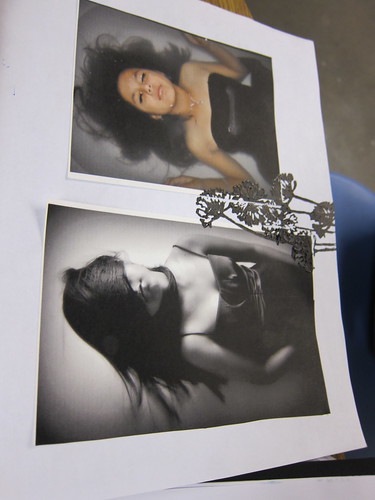
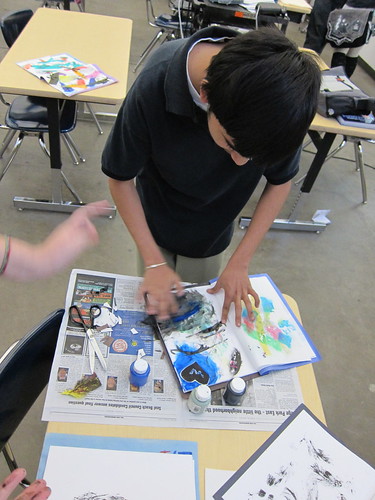

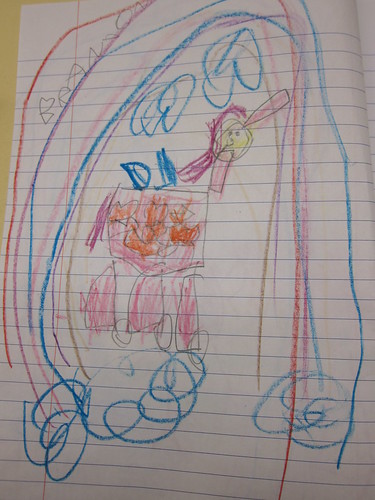

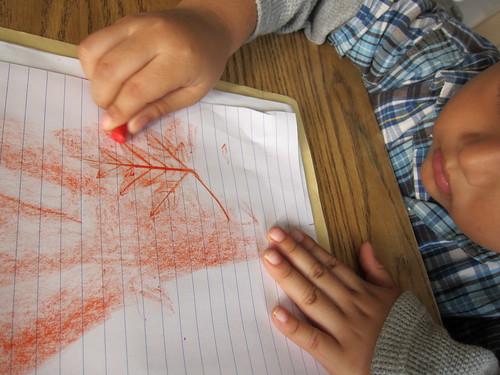
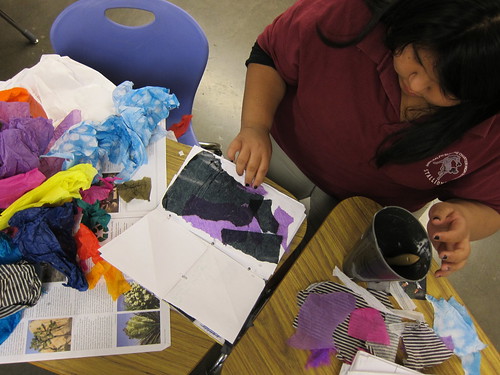
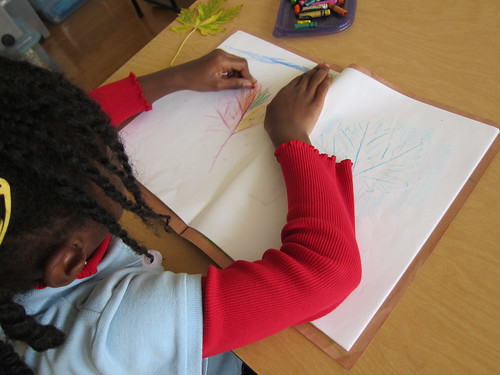
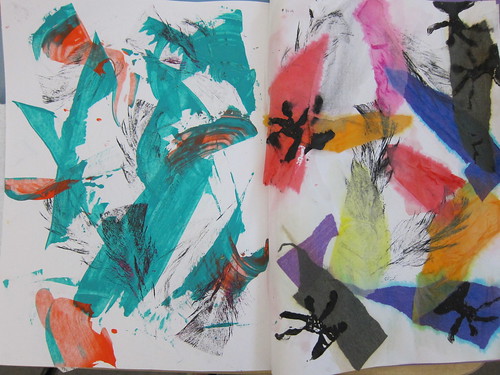

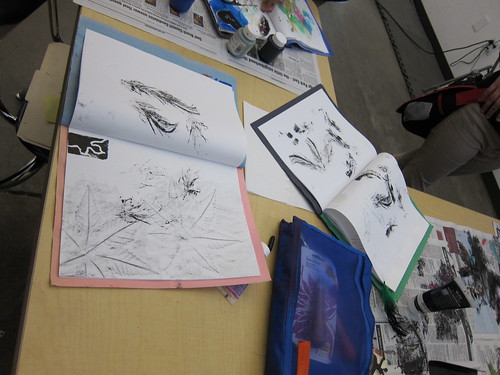
Below are some photos from recent journal time. Our high school students have been playing with new image making techniques, learning about creating ‘artists books’. On occasion, we’ll bring something in to inspire our elementary students as well - in this case, some fall leaves were all they needed to run wild!











Thursday, November 04, 2010
Día de los Muertos
Our students have been working on some really cool Day of the Dead projects this past week. This is one of our favorite themes - a great springboard to teach students about cultures, symbolism, cycles in nature, Mexican and Aztec history, etc.

Students are cutting their own papel picado, and learned about graphic designer Jose Posada and his drawings in Mexico 100 years back that influenced much of the Día de los Muertos imagery we see today.
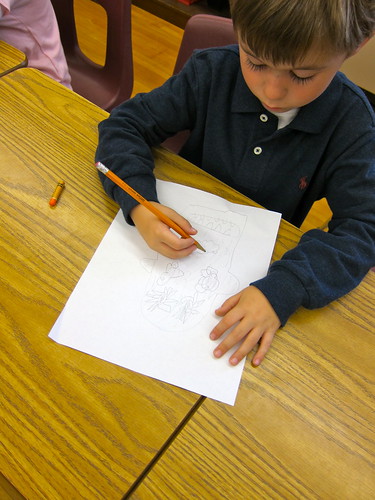
They are creating their own calveras, putting their own personal cultural spins on them. So far, we’ve seen a few with ipods, one with a helmet to represent skateboarding, a student who is into drawing who gave his pencils for teeth, another student of Japanese heritage gave his the rice hat that is grandfather wears.

Watch for more photos as the students begin to complete their projects!
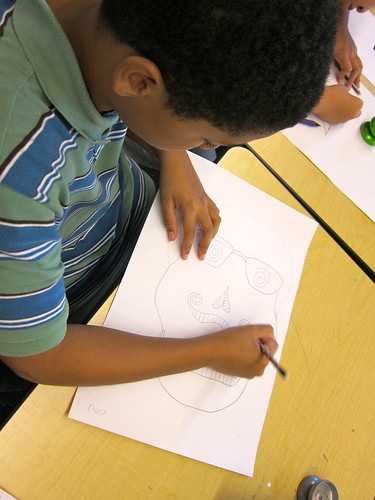


Students are cutting their own papel picado, and learned about graphic designer Jose Posada and his drawings in Mexico 100 years back that influenced much of the Día de los Muertos imagery we see today.

They are creating their own calveras, putting their own personal cultural spins on them. So far, we’ve seen a few with ipods, one with a helmet to represent skateboarding, a student who is into drawing who gave his pencils for teeth, another student of Japanese heritage gave his the rice hat that is grandfather wears.

Watch for more photos as the students begin to complete their projects!


Thursday, October 28, 2010
Lots of exciting work!
Living Histories is back in action and back to school!
We are working with several Green Dot charter high schools in a partnership with Champions; we are currently at Animo South LA, Animo Pat Brown, and Animo Bunche, where teachers Jennifer and Steve are working with some amazing students doing photography.
The students this session are focused on learning core ideas in composition, looking at the work of other photographers, developing their own portfolios, and doing conceptual projects around their own identity and role in their community. They also keep journals and practice various printmaking and painting techniques to give them creative ideas; a bit focus on the class is the creative process itself.
We are so excited to see the work they are producing!

student project at animo bunche
A show is in the works for December - more info soon - but in the meantime, check out what they are doing on their blogs:
http://www.animophotography.blogspot.com/
http://patbrownphoto.blogspot.com/
We also just started up at New LA Charter, a middle school. Steve is teaching a "DIY Graphic Design" class to students there. Right now, they are making some very cool Día de los Muertos posters, having learned about Mexican graphic designer Jose Posada. They'll soon be embarking on some cool projects, including creating logos, a website, a magazine, designing their own business, and picking a community project to apply their new design skills too. They are a great group of students, and we are excited to be working with them!
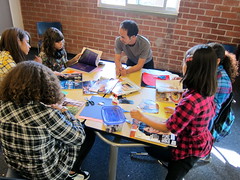
Miss Tiffany is back at Hamilton Elementary in Pasadena, as part of our on going partnership with the Pasadena LEARNs program. She is teaching classes to some K-2nd graders; right now, the students are focused on learning about concepts connected to community, culture and identity (and they too are doing some Día de los Muertos projects as part of their culture explorations) and will soon be engaged in learning about water issues around the globe, engaging in art and writing projects connected to such, and then taking part in a group service project to bring a needing community clean water. We are very excited to get them started on this!
We also promise to have more regular updates - needless to say, it's been a busy 6 or 7 weeks starting this school year up, but we can't want to share more of what our students create!
-Brande
We are working with several Green Dot charter high schools in a partnership with Champions; we are currently at Animo South LA, Animo Pat Brown, and Animo Bunche, where teachers Jennifer and Steve are working with some amazing students doing photography.
The students this session are focused on learning core ideas in composition, looking at the work of other photographers, developing their own portfolios, and doing conceptual projects around their own identity and role in their community. They also keep journals and practice various printmaking and painting techniques to give them creative ideas; a bit focus on the class is the creative process itself.
We are so excited to see the work they are producing!

student project at animo bunche
A show is in the works for December - more info soon - but in the meantime, check out what they are doing on their blogs:
http://www.animophotography.blogspot.com/
http://patbrownphoto.blogspot.com/
We also just started up at New LA Charter, a middle school. Steve is teaching a "DIY Graphic Design" class to students there. Right now, they are making some very cool Día de los Muertos posters, having learned about Mexican graphic designer Jose Posada. They'll soon be embarking on some cool projects, including creating logos, a website, a magazine, designing their own business, and picking a community project to apply their new design skills too. They are a great group of students, and we are excited to be working with them!

Miss Tiffany is back at Hamilton Elementary in Pasadena, as part of our on going partnership with the Pasadena LEARNs program. She is teaching classes to some K-2nd graders; right now, the students are focused on learning about concepts connected to community, culture and identity (and they too are doing some Día de los Muertos projects as part of their culture explorations) and will soon be engaged in learning about water issues around the globe, engaging in art and writing projects connected to such, and then taking part in a group service project to bring a needing community clean water. We are very excited to get them started on this!
We also promise to have more regular updates - needless to say, it's been a busy 6 or 7 weeks starting this school year up, but we can't want to share more of what our students create!
-Brande
Tuesday, August 24, 2010
Living Histories Newsletter
As Living Histories prepares to embark into our 12th school year, we wanted to fill you in on some of the highlights from 09/10, and let you know what we’ll be presenting for 10/11!
ELEMENTARY SITES
We were excited to return to Longfellow Elementary again last year, a school that is close to our hearts and one we have been serving students at for nearly ten years now. We also presenting programming at Hamilton Elementary, a new school site for us but one that welcomed us with open arms!
At both sites, our young students embarked in a curriculum that taught them about the connection between community and ecology, developed their creativity and critical thinking skills, exposed them to art and art techniques from around the world, incorporating journaling, and got them writing creatively nearly every class session!
Below are just a few of the highlights of our work from last year:
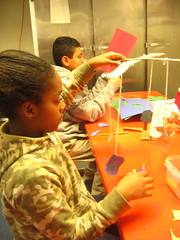
‘Ecosystem Mobiles’ introduced students to the work of Alexander Calder, and was a hands on project to teach them about the interconnectedness of life in both nature and a community.
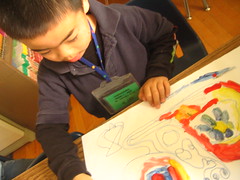

Building on what they learned about Calder, students then created some beautiful abstract paintings that were inspired by ‘nature shapes’ they found around their own campus.
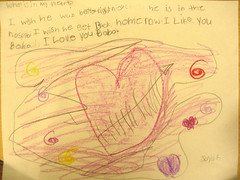
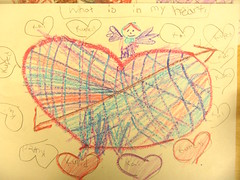
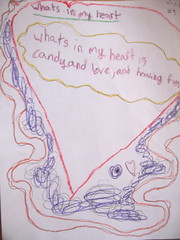
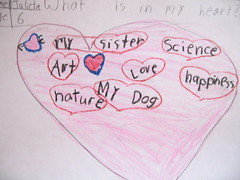
Students took part in a public art project where participants were asked to answer the question ‘what is in your heart’ with writing or drawing - it was also a great lesson on the differences between ‘literal’ and ‘figurative’! Their work was featured in a gallery in Santa Monica with all of the other participants.
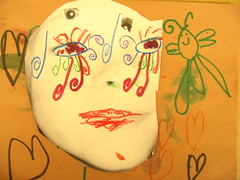
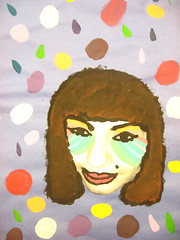

Self portraits made by manipulating copies of photographs
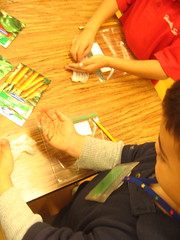
Growing seeds and doing projects connected to our ‘window’ gardens was another popular project!
You might have seen some of their work at the Starbucks on Washington and Lake, which generously allowed us to showcase some of our student work there this past spring. We hope to have more work up once the fall semester begins!
HIGH SCHOOL
On the high school front, we joined up with Marshall Fundamental for their last quarter, working with students in a digital arts class.
Students used Living Histories cameras to create photographs and video, and learned to use programs like Photoshop and iMovie to create finished products that showcased their school, their personal lives, their friends, etc.
You can check out some of their work here: http://eagleediting.blogspot.com/
A video they created with Living Histories teacher and filmmaker Lori Hope can be found here: http://www.youtube.com/watch?v=2nlLQZPemPU
We also formed a new partnership with CHAMPIONS: Adventure, After School and Sports Program and Green Dot charter schools, working at Amino Justice and Amino Bunche with high school students. Though we were only with the students for a short few weeks, the class was incredible; taught as a college art course would be, students examined the work of professional and amateur photographers from the standpoint of self expression, and then set out to create their own work. Like all of our courses, students also kept a journal and incorporated writing, drawing and collage into their work.
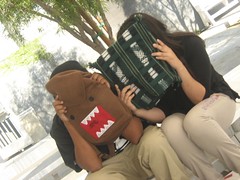
Their efforts cumulated into a art exhibit held at a local Starbucks that donated wall space; students helped to display the work, getting hands on experiences as curators, and hosted visitors at the grand opening on a Saturday evening. It was an amazing experience - we are so proud of our students!
Check out the Amino blog, including detailed info on the art exhibit, here:
http://animophotography.blogspot.com/
More student photography can be found here:
http://www.flickr.com/photos/living-histories/
10/11 PROGRAMMING
To view and download our elementary, high school, and middle school programming for the 10/11 school year, visit our website:
http://adventuresafterschool.blogspot.com/2010/08/living-histories-1011-programing.html
We are still accepting new sites for the 10/11 school year and would love to discuss new partnerships! Email us for more information!
Want to see more? Visit the rest of our blog for more updates from last year:
www.adventuresafterschool.blogspot.com
A big thanks to PUSD LEARNs, Champions, Green Dot and our site coordinators: Marie, Mary, Jack, and Leon for all of their support and help in 09/10!
Monday, August 23, 2010
Living Histories 10/11 Programing
Below is an overview of what we have planned for the 10/11 school year; this is in many ways just a template, as we customize our programs based on the needs of a specific school site.
If you are interested in having Living Histories at your school or community site,
please email us for more information!
If you are interested in having Living Histories at your school or community site,
please email us for more information!
Elementary Sites
Elementary (and middle school) sites this school year will be engaged in two semester long thematic topics:
‘Clean Water’ will be the topic for the first semester; students will be examining the issue of clean water as it pertains to communities around the world. They’ll be engaged in art projects connected to those communities and their traditions, while also using ‘water’ as an inspiration in their work. Tapestries, bark painting, photography, and self portraiture are just some of the many projects they’ll engage in as part of this project. The semester will cumulate with a student initiated and led service project designed to help a community of youth elsewhere get access to clean drinking water, done via a partnership with a global
non-profit organization. Older elementary students will also be documenting and reporting on this process.
For the second semester, students will be looking at sustainable living practices around the world, as well as social entrepreneur models. A big focus will be on creating community gardens and using them as a model to teach ecology, business skills, nutrition, and community building, as well as using them as the inspiration for accompanying art projects. The focus on this semester is to get students to think about using their creativity for the larger social good, and helping them find means by which to do so, while still developing specific artistic and writing skills along the way.
When access to computers are available, students of all ages will engage in video and photo editing, animation, graphic design and blogging in conjunction with these projects.
Middle School Sites
Our middle school sites will be following the same thematic concept as our elementary sites, but will offer students a chance to take a much more hands on approach to the service learning projects and a more technical approach to their art and writing projects. Our middle school sites blend the conceptual ideas of our elementary sites with the technology used at our high schools; a middle school site, for example, might engage in a photojournalism project connected to a community need and create a service project around that idea. For our middle school sites, we strike a balance between providing the structure and consistency that middle schoolers need with the sense of autonomy and social component they want, which in turns keep enrollment levels high.
We plan on hosting a community wide exhibit of student work at the end of each semester.
High Schools
Our high school classes will include:
Photography
A class that looks at photography as a means of documentation and self expression. The class is taught in a ‘collegiate style’, with students studying the work of other photographers and exploring concepts relating to identity and community, while also growing and learning as photographers; learning photo techniques and theories and building their own personal portfolio, which could later be used for college admission purposes. Students will shoot and critique their work weekly, and also keep a journal as part of the class. As a final project at the end of each semester, students will have a show of their work and will create a blog. Students will use Living Histories’ digital cameras, and if possible, school provided computers for editing.
School requirements: any ‘style’ of classroom
Useful school options: use of computers with Photoshop or other photography editing software and internet connection
Digital storytelling
This class incorporates photography with journalism and creative writing; students tell stories of their lives and of their community through photography and writing that they feature on a website (as a group or personal) that they create. Emphasis is placed on using photography as a means to tell a story, and to think about both photography and writing as a means of recording the individual stories that encompass our larger community. Students will use LIving Histories’ digital cameras and school provided computers, and in addition to creating a website, will also have a ‘group show’ and create a ‘literary magazine’ as final projects.
School requirements: any ‘style’ of classroom; use of a computer lab or several laptop computers with photo editing software and internet access
Creative Journaling
This is an art class designed to inspire creativity and creative thinking, and to help students work through creative ‘blocks’ so that they can lead fuller lives. This is a very hands on, studio focused art class that allows students to gain access to a wide variety of new techniques and mediums while also refining their fine art skills, and working to help them conceptually develop creative and critical thinking skills. Students will create actual ‘artist books’ of their work, incorporating collage, image transfers, drawing, painting, photography, and creative writing all together for the purpose of personal expression. Students interested in pursuing an art focused college program would also be able to use their books as part of a portfolio.
School requirements: ideally, use of an art classroom that will allow students to paint and use other art techniques that might be too messy for a regular classroom
Graphic Design
Students will learn the basics of design theory and fundamental graphic design, learning Photoshop and InDesign, creating logos for companies they will create (both theoretical and real community initiatives), posters, business cards, brochures, etc. Emphasis will be on design skills, and then on identifying places in the community that could benefit from such design skills/putting skills to ‘real world’ use.
School Requirements: access to computers with adequate design software
Community Leadership
A class designed to help students identify community issues they want to address and the skills and techniques needed to do so. Students will collectively decide on issues within their community that they want to address and will then learn skills need to do so: communication, organizing, recruiting volunteers, addressing local political leaders, marketing, fundraising and financial management and advocacy. The class is designed to allow students to learn fundamental business and marketing skills in the context of leading an initiative for their local community (or, optionally, by working on a larger ‘global’ issue if they so choose) to create positive change.
School Requirements: a ‘regular’ classroom and access to several computers with internet access.
Documentary Video
In this class, students will learn the fundamentals of documentary video: technical skills around shooting and editing, and larger ‘conceptual’ skills around storytelling and the nature of documentaries. Students will create several pieces using Living Histories’ provided digital video cameras: video blogs for the website they will create, short pieces about people and institutions in their community, and a ‘Public Service Announcement’ meant to address a community issue they determine to be of importance to them as a group.
School Requirements: a ‘regular’ classroom and ideally access to computers with video editing software such as iMovie or Final Cut Pro.
Subscribe to:
Posts (Atom)
